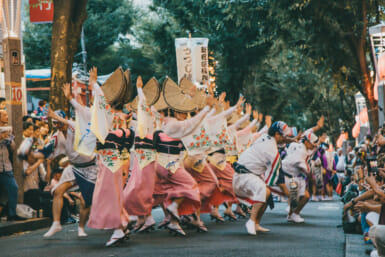by Tanya Korinfsky
Taking taxis — or how not to let a taxi take you
Taking a cab in Japan is never a dull experience. Frustrating, terrifying, nerve-wracking, blood-pressure raising, funny, educational, pleasant, interesting — yes. Dull, no.
I’ve had cab drivers try to run me down, swear at me, give me Japanese lessons and play the koto (a small one) at red lights. More than just a transporter of people, the cabbie, through the scores of passengers he picks up every day, has a finger on the pulse of the nation like few others. If I want to get the mood of the populace on Lockheed, take no ko zoku or taxes, I take a cab.
Even unsolicited, the cabbie will frequently give you potted opinions — where Japan went wrong in World War II, how “international” Japan has become and what’s wrong with present-day Japanese.
Now, taking a cab: Although on occasion a taxi may take you. I have found that, as a rule, if you approach cab drivers politely and circumspectly, you are half-way there. Getting there, however, involves getting a cab. Surprisingly, a red light on the left-hand side of the windscreen means that the cab is vacant. This does not necessarily mean that the cab will stop.
A green light in the same place means that the cabbie has a fare. Sometimes you will notice that the green light is on, although there is no passenger. This usually means he’s on his way to pick up a fare. Some cab drivers are open to negotiation — some people raise a certain number of fingers to denote how many times the normal fare they’re willing to pay. Don’t raise four fingers, however. This means you think the cabbie is an animal, and he may try to clip your kneecaps as he roars past or give you a shower if it’s a rainy day.
Finally, there’s a sign, written in red on a white card, again in the left side of the windscreen, that means the cab driver is on his way back to his base or home, and usually he won’t stop.
Generally, you can easily flag down a cab during daylight hours. But don’t do it while standing on a pedestrian crossing, at a bus loading zone or at a busy intersection. If it looks as if the cab will stop, don’t run up and start clawing at the door handle or the cabbie may think you’re an escaped lunatic and take off. Stand well back from the rear back door, which opens and closes automatically (even people who have been here for months still find themselves being knocked silly by the cab door flying open) and when you’re in, tell the cabbie, slowly, if you’re speaking English, your destination.
Never give him an address on a piece of paper, unless it’s accompanied by a map (even then, there’s no guarantee that he’ll find it). Never begin your sentence with things like. “I would like to go to…” or “I want you to take me to . ..” All these extra words confuse him. Just state the destination. “Hotel Okura, please” is enough.
Generally, cab drivers do not know where lesser-known buildings are. Don’t tell him “Ikeda Building in Shibuya.” Give him some landmarks to head for, if you know where the place is, such as Shibuya Station, Parco, etc.
When you get to your destination, try to pay in small denominations of money. Cab drivers quickly get surly if you hand them ¥10,000 for a ¥430 fare. Some won’t have the change. A small tip is a nice gesture if he’s been particularly helpful but, as a rule, you are not expected to tip.
There is no extra charge for baggage handling or putting your bags or cases in the trunk.
For a medium-sized cab (front bench seat type), the passenger limit is five. (Four, if the front seats are bucket type.) But most cab drivers resent being squashed up against the door by five burly foreigners. One group of five hefty foreigners I was once with wore down the initial resistance and scowls of the driver by singing all the way. By the time we got to our destination, he was all smiles and convinced he had just run into a famous touring choral group.
Foreigners frequently complain that it is impossible to get a cab in certain districts at certain hours, such as Akasaka at 12:30 a.m. Some have even complained to the local koban, to no avail. In such areas, it’s sometimes quicker to head for the designated cab ranks, e.g. Akasaka Tokyu Hotel. Empty cabs are required to stop if you wave them down, but as we all knew, some don’t, especially during the “witching hour.”
If you have a legitimate complaint, e.g. a cab with the “vacant light” on doesn’t stop, the driver takes you the long way or refuses to take you to your destination after you get in the cab, you should note the cab company’s name and the door number (displayed on the outside of the door) and call 355-0300 and state your complaint. When I did this once, I was called back several days later, with another apology and an assurance that the offending cab driver had been reprimanded. So, redress is possible.
The same number applies if you’ve left something behind in a cab. Try to call between 9 a.m. and 5 p.m. If you fail to get the door number, try to get the license plate number. If you didn’t get it, don’t despair, as there is every chance your forgotten article will still turn up.
Not all cab drivers will take you for a ride. If you can read kanji, try to flag down the individually owned and operated cabs. Even if you don’t understand characters, these cabs are usually recognizable by their white-gloved, neatly attired drivers, the spotless condition of the cab, the fancy sound system, the lace-covered seats and the superior politeness of the driver. A most pleasant and satisfying experience.
While you may take animals in a cab, one cab driver suggested to me, “Make sure you have the animal in a tight grip or in a basket.”
Although cab drivers generally have a reputation for being a surly lot — I’ve known people who’ve moved house by cab, taken pet snakes for a ride or forgotten how to get home — they usually respond to polite customers who can give clear directions. And even if they can’t always find the place you’re going to, they’re a goldmine of information and good for a quick rundown of what makes Japan tick.








